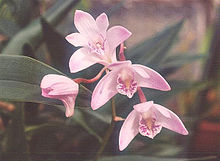
Dendrobium

Dendrobium is a genus of mostly epiphytic and lithophytic orchids in the family Orchidaceae. It is a very large genus, containing more than 1,800 species that are found in diverse habitats throughout much of south, east and southeast Asia, including China, Japan, India, the Philippines, Indonesia, Australia, New Guinea, Vietnam and many of the islands of the Pacific. Orchids in this genus have roots that creep over the surface of trees or rocks, rarely having their roots in soil. Up to six leaves develop in a tuft at the tip of a shoot and from one to a large number of flowers are arranged along an unbranched flowering stem. Several attempts have been made to separate Dendrobium into smaller genera, but most have not been accepted by the World Checklist of Selected Plant Families. Dendrobium species are mostly epiphytic, or lithophytic although a few species are terrestrial. They are sympodial herbs with cylindrical roots usually arising from the base of a pseudobulb. The pseudobulbs, when present, are hard, sometimes cane-like, cylindrical or cone-shaped and more or less covered with the bases of the leaves. There are from one to many leaves arranged in two ranks, the leaves varying in shape from linear to oblong, sometimes cylindrical but never channelled or grooved. They are usually much longer than wide and last for only a single season. Between one and a large number of resupinate or non-resupinate flowers are arranged along an unbranched flowering stem and may be short or long-lived. The flowers may be white, green, yellow, or pink to purple, often with contrasting colours in the labellum. The sepals and petals are usually free from and more or less similar to each other but markedly different from the labellum. The labellum is more or less egg-shaped, with the narrower end towards the base and flanks the column. There is often a callus consisting of narrow, parallel ridges, in the centre of the labellum. The genus Dendrobium was first formally described in 1799 by Olof Swartz and the description was published in Nova Acta Regiae Societatis Scientiarum Upsaliensis. The name Dendrobium is derived from the Ancient Greek words dendron meaning 'tree':813 and bios meaning 'life',:478 referring to the epiphytic habit of most species. In 1981, Friedrich Brieger reclassified all terete-leaved dendrobiums from Australia and New Guinea into a new genus, Dockrillia and in 2002 David Jones and Mark Clements separated the genus into smaller genera, including Thelychiton, Tropilis, Vappodes and Winika but all of these genera are regarded as synonyms by the World Checklist of Selected Plant Families. They have adapted to a wide variety of habitats, from the high altitudes in the Himalayan mountains to lowland tropical forests and even to the dry climate of the Australian desert. Dendrobium is commonly abbreviated as Den. in horticulture. Some species are in great demand by orchid lovers. This has resulted in numerous varieties and hybrids, such as the Noble Dendrobium (Den. nobile) breeds, which have greatly extended the range of colors of the original plant from the Himalayas. The flowers of Cuthbertson's Dendrobium (Den. cuthbertsonii) have been reported to last up to ten months each. Many Dendrobium species are known to vigorously remove toluene and xylene from the air.
